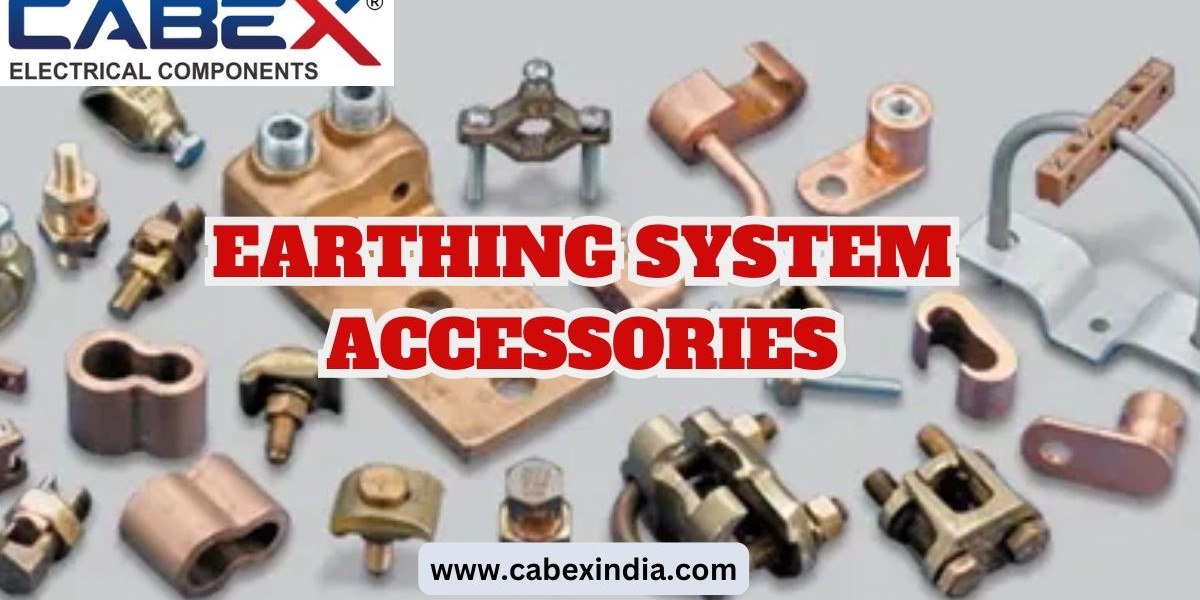When it comes to electrical installations, the importance of a properly designed and maintained earthing system cannot be overstated. An efficient earthing system prevents the risk of electric shock, ensures the protection of electrical equipment, and helps avoid potential fire hazards. However, the success of this system largely depends on the use of high-quality Earthing System Accessories. These components not only play a critical role in establishing effective grounding but also contribute to the system’s durability, safety, and compliance with standards.
In this article, we explore the essential earthing system accessories, their functions, and how they work together to provide a reliable and secure grounding system. Understanding these components is key to maintaining a safe electrical infrastructure, whether in residential, commercial, or industrial applications.
What Are Earthing System Accessories?
Earthing system accessories are the various components that complement the primary elements of an earthing system—such as the earth rods and conductors—to establish a secure and effective ground. These accessories are vital for achieving low-resistance grounding, which is necessary for electrical fault protection. Proper selection and installation of these accessories are essential to ensure the system’s efficiency, safety, and longevity.
Key Types of Earthing System Accessories
The key accessories that form part of an earthing system include earth rods, earthing clamps, cable lugs, earth busbars, earth plates, and earth pit covers. Each accessory has a specific role to play in creating a reliable and secure connection between the electrical system and the ground.
1. Earth Rods: The Foundation of Your Earthing System
Earth rods are the cornerstone of any earthing system. They are long metal rods, typically made of copper, galvanized steel, or copper-bonded steel, which are driven deep into the ground to create an electrical path to the earth. The primary function of the earth rod is to direct electrical currents, such as fault currents, safely into the ground, preventing any harmful effects from arising in the electrical system.
Types of Earth Rods:
- Copper Earth Rods: Copper is known for its excellent electrical conductivity and corrosion resistance. Copper rods are ideal for areas with low soil conductivity and can provide optimal performance even in harsh environmental conditions.
- Galvanized Steel Earth Rods: Galvanized steel rods are highly durable and resistant to corrosion. They are often used in environments where moisture and humidity levels are high, such as coastal areas.
- Copper-Bonded Steel Earth Rods: These rods combine the strength of steel with the conductivity and corrosion resistance of copper. They offer the best of both worlds, providing high performance and durability, making them suitable for a wide range of installations.
2. Earthing Clamps: Ensuring Secure Connections
Earthing clamps are used to securely connect the earthing conductor to the earth rod or earth plate. These clamps ensure a strong, reliable, and lasting connection, which is essential for efficient current transfer. They come in various designs, including bolt-type clamps, compression clamps, and screw-type clamps, each suited for different types of connections.
Types of Earthing Clamps:
- Compression Clamps: These are ideal for securing large conductors, ensuring a tight, secure connection by applying mechanical pressure. They are typically used in industrial applications where a higher current load is expected.
- Bolt-Type Clamps: Used for general-purpose connections, bolt-type clamps are versatile and easy to install. They are commonly used in smaller installations and residential systems.
- Screw-Type Clamps: These clamps are designed for flexible connections, offering a quick and easy way to attach cables or conductors to the earthing rod or plate.
3. Cable Lugs: Efficient Conductive Connections
Cable lugs are used to connect the earthing conductor to other components of the earthing system, such as earth rods, busbars, or plates. These lugs are designed for use with various conductor sizes and types and are typically made of copper, aluminum, or brass.
The primary function of cable lugs is to ensure a secure and efficient connection between the conductor and other earthing components. They are available in crimp-type, screw-type, and bolt-type designs, making them versatile for different installation needs.
4. Earth Busbars: Distributing Fault Currents Safely
An earth busbar serves as a central distribution point for multiple earthing conductors, allowing for the efficient distribution of fault currents to the ground. It is a metallic bar, often made of copper or aluminum, used to interconnect various earth rods or earth plates within a network.
Earth busbars are primarily used in large-scale electrical systems, such as industrial or commercial installations, where multiple earthing points need to be interconnected. The use of busbars ensures the even distribution of fault currents, reducing the likelihood of damage to electrical equipment and improving the safety of the entire system.
5. Earth Plates: Low Resistance Grounding Solutions
Earth plates are flat, conductive plates made from materials like copper or galvanized steel. These plates are buried in the ground to create a low-resistance connection to the earth. They are often used in areas where the soil is not ideal for the installation of earth rods or where additional surface area is required for grounding.
Earth plates are particularly useful in areas with high soil resistivity, as they provide a larger contact area with the ground, helping to improve the grounding effectiveness.
6. Earth Pit Covers: Protection and Maintenance
An earth pit is a hole where the earth rod or earth plate is buried, and earth pit covers are used to protect the pit and its contents. These covers prevent dirt, debris, or moisture from entering the pit, ensuring that the earthing system remains intact and functional.
Earth pit covers are typically made from plastic, steel, or composite materials. They are available in different designs to suit various installation requirements and ensure long-term protection.
Why Are Earthing System Accessories Crucial for Electrical Safety?
A properly installed earthing system is the first line of defense against electrical faults, preventing dangerous scenarios such as electric shock or equipment damage. The accessories used in the system are vital for maintaining this safety. Here are some reasons why earthing system accessories are essential:
1. Enhanced Safety and Fault Protection
The primary role of an earthing system is to safely dissipate electrical fault currents into the ground. Accessories like earth rods, clamps, and cable lugs ensure that these currents are safely and effectively directed, reducing the risk of electrical shocks, fires, or damage to sensitive equipment.
2. Improved System Performance
Using high-quality earthing accessories ensures that the system remains efficient with minimal resistance. Low-resistance grounding helps protect electrical equipment from damage due to voltage surges, lightning strikes, or other electrical faults, ensuring the longevity of both the system and connected devices.
3. Compliance with International Standards
Compliance with safety regulations is crucial for any electrical installation. By using the appropriate earthing accessories that meet national and international standards (e.g., IEC, NEC, BS standards), you can be confident that your earthing system is designed to protect people and equipment while adhering to safety guidelines.
4. Durability and Longevity
The materials used in earthing accessories—such as copper, galvanized steel, and copper-bonded steel—offer resistance to corrosion and environmental factors. This durability ensures that the earthing system remains functional for many years, reducing the need for frequent replacements or maintenance.
Conclusion
The importance of high-quality earthing system accessories cannot be overstated. These components ensure the effectiveness, reliability, and safety of your earthing system, protecting both your electrical infrastructure and the people around it. From earth rods and clamps to busbars and cable lugs, each accessory serves a vital purpose in ensuring safe electrical installations.
When selecting the right earthing accessories, it is essential to consider factors such as material quality, environmental conditions, and compliance with safety standards. By doing so, you ensure that your earthing system provides reliable protection and contributes to the safe operation of your electrical installations.
For more information on premium earthing system accessories, please visit Cabex India.









